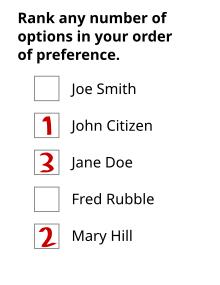| A joint Politics and Economics series |
| Social choice and electoral systems |
|---|
 |
|
|

A first-preference is a voter's most-preferred candidate.[1][2][3][4] In certain ranked systems such as first preference plurality, ranked-choice voting (RCV), and the single transferable vote, first preferences for a candidate are considered most important and prioritized heavily. This incentivizes pandering to the political base or "core support" as a result of the center squeeze effect. Methods like Condorcet voting, rated voting, and the Borda count do not exhibit such effects. Methods like anti-plurality voting and Coombs' method have the opposite effect, being dominated by a voter's bottom rankings and so tending to elect the "least offensive" candidates.
First-preference votes are used by psephologists and the print and broadcast media to broadly describe the state of the parties at elections and the swing between elections.[4][5][6] The term is much-used in Australian politics, where ranked voting has been universal at federal, state, and local levels since the 1920s.
- ^ "Explainer: What is preferential voting?". Special Broadcasting Service. Retrieved 10 August 2024.
- ^ "How the Dáil is Elected" (PDF). Department of the Environment, Community and Local Government, (Ireland). November 2014. p. 10. Retrieved 24 May 2015.
- ^ ""Full transcript - David Cameron - The case against AV - London - 18 February 2011"". New Statesman. 18 February 2011. Retrieved 24 May 2015.
- ^ a b "By-Election: Carlow-Kilkenny". RTÉ. 23 May 2015. Retrieved 24 May 2015.
- ^ "First Preference Vote". University of Western Australia. Retrieved 24 May 2015.
- ^ "Cooma-Monaro Shire Council: Summary of First Preference Votes for each Candidate". Local Government Elections 2012. Electoral Commission of New South Wales. 14 September 2012. Retrieved 7 October 2012.
